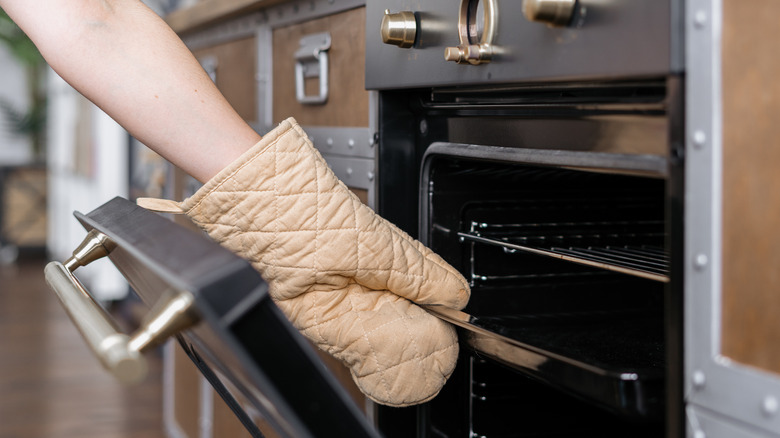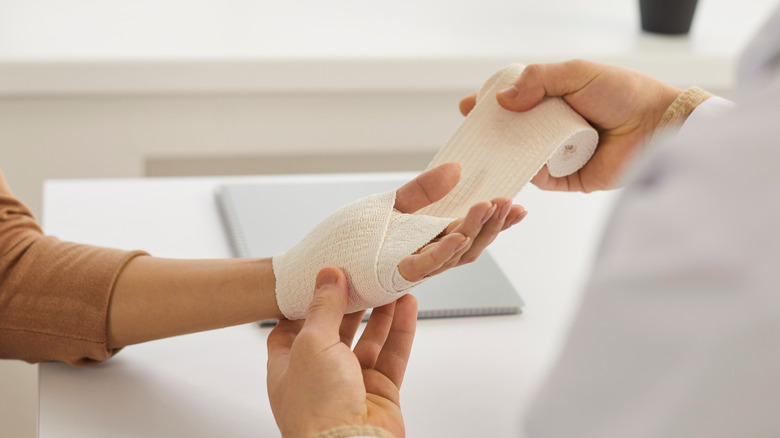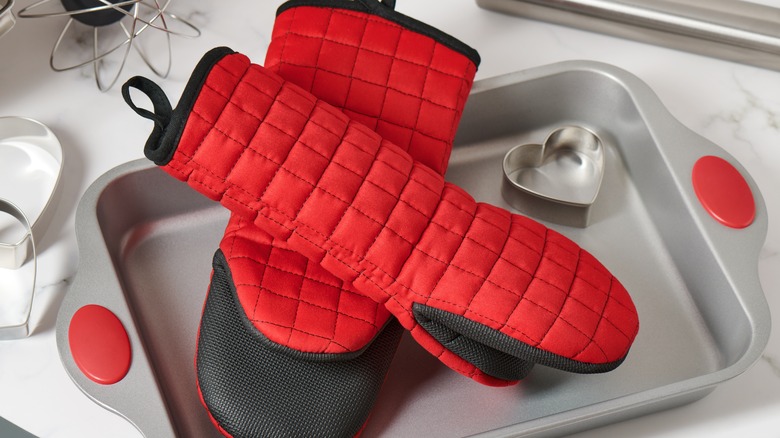You Should Never Use Wet Oven Mitts. Here's Why
Cooking and baking are a matter of harnessing and finessing conductivity. It's why we use certain fats like oil and butter to sear and sauté, why we dry roast, and why we braise or boil. It's also why we use an ice bath to shock blanching vegetables, cool a custard, or chill a bottle of wine super fast. However, it's also exactly the thing you don't want to subject your hands to in the kitchen.
Imagine: The oven timer dings. You slip your hands into your oven mitts and open the door to a waft of mouth-watering steam. You pick up the roasting pan and, in a split second, you feel searing pain. Maybe you barely manage to set it down safely and rush over to the sink to hold your hands under cold water. You'll be nursing these burns through dinner and beyond, assuming you didn't ruin dinner by dropping the pan.
Where did you go wrong? Your oven mitts were wet.
The way of water and burned hands
Water is an excellent conductor — 25 times more conductive than air according to the American Meteorological Society. A freshly washed but still-damp hand inside an oven mitt, a mitt left on the counter in a wet spot, or a steamy pot lid placed on top of a mitt can spell disaster because of this principle of thermodynamics, and it's why dry oven mitts are critical to kitchen safety.
A study conducted by Dr. Adriana Petrova, associate professor at Oklahoma State University, found that a damp oven mitt exposed to 350 to 400 degrees Fahrenheit temperatures for as little as one second can cause third-degree burns on the hand inside it. Second-degree burns can occur at 160 degrees Fahrenheit.
Not even the quickest hands in the kitchen can outrun the thermal transfer of a wet mitt on a hot pan, but some materials and constructions will protect you better than others.
Best oven mitt materials and construction
Certain materials are going to have better R-values, or resistance to thermal change, than others. Just as your attic is better insulated with fiberglass batting than steel, a fabric or silicone oven mitt made with a layer of batting is going to protect your hands a lot more effectively than a thin towel or a chainmail glove (regardless of how cool you look).
Why? Because they have a low conductivity and an insulating layer. Air is an efficient insulator, and these materials trap air. If you're the kind of person who likes to sleep outside in a sleeping bag, you know that puffy synthetics and airy down feathers are going to keep you from becoming an icicle in the woods overnight. The batting in an oven mitt does the same thing.
Similarly, construction is critical to keeping your soft hands safe. Because the insulation is compressed under stitching, there will be less resistance to thermal transfer, as Dr. Petrova found in her study. You also need to make sure it won't melt during use like these ill-fated Marvel mitts.
All of this comes down to an oven mitt that resists dampness, like silicone, with a layer of batting and no seams on the surfaces that touch hot pans, such as the palms and fingers. If you're not ready to give up your fabric mitts, make sure they don't have stitching compression in sensitive areas and, most importantly, that they stay dry.


